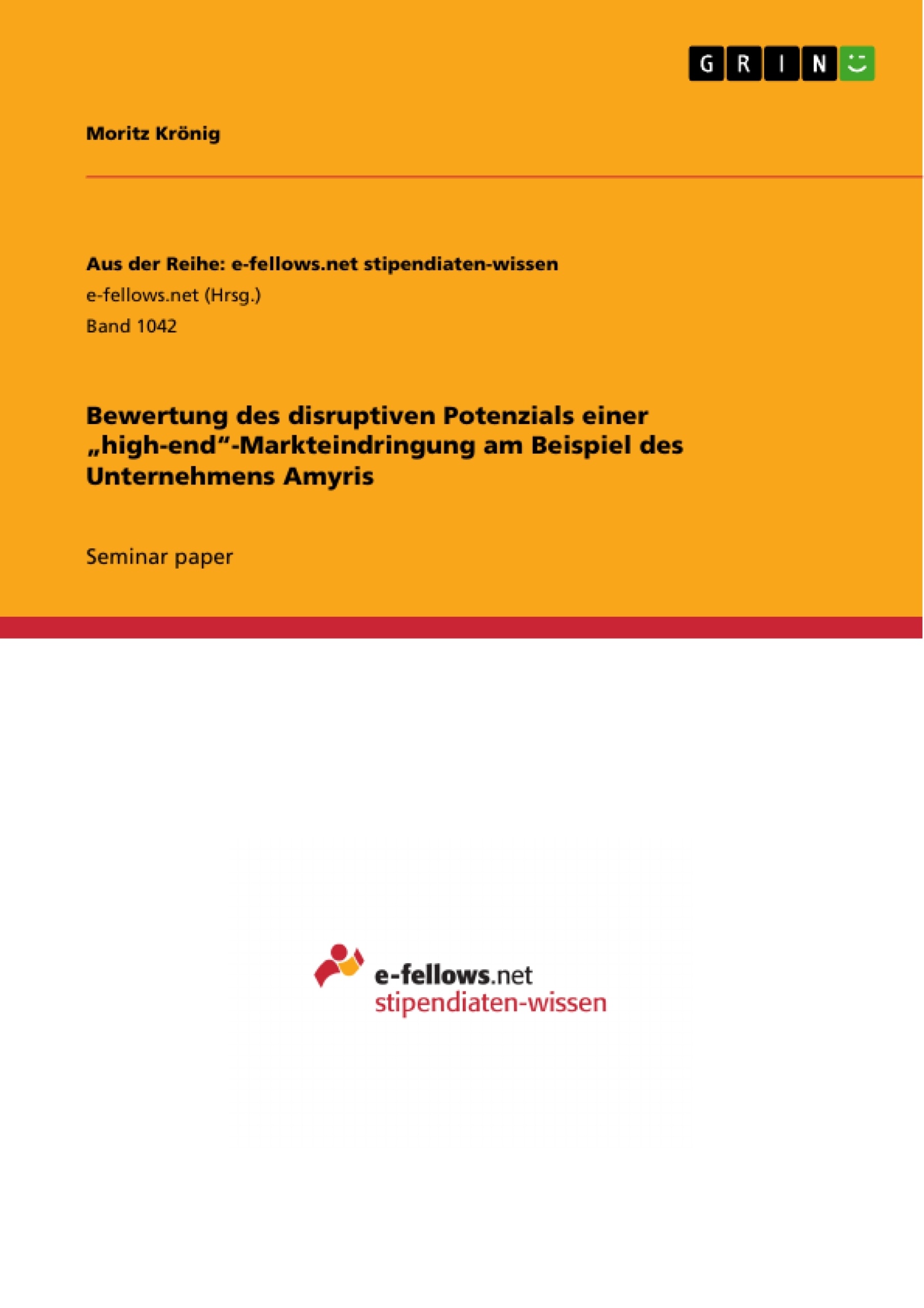Disruptive Innovationen bringen etablierte Unternehmen immer wieder in Bedrängnis, oder lassen diese sogar scheitern. Sie verdrängen erfolgreiche Technologien häufig vollständig und innerhalb kurzer Zeit.
Wissenschaftlich beschrieben wurde die disruptive Innovation das erste Mal 1997 von Clayton M. Christensen. Umfassend beschreibt er das Konzept der disruptiven Innovation jedoch nicht, denn er befasste sich ausschließlich mit dem später so genannte „low-end encroachment“, das Eindringen in einen Markt vom unteren Marktsegment beginnend. Daher wurde seine Theorie mehrfach erweitert und zusätzliche Arten disruptiver Innovationen beschrieben, so zum Beispiel das „high-end encroachment“, das Eindringen in einen Markt vom oberen Marktsegment beginnend (Van Orden et al., 2011). Allen Arten disruptiver Innovationen ist gemein, andere Technologien von einem Markt zu verdrängen (Utterback and Acee, 2005; Van Orden et al., 2011).
Viele wissenschaftliche Arbeiten über disruptive Innovationen nehmen für die Feststellung einer disruptiven Innovation eine ex-post Bewertung vor. Deutlich wertvoller, vor allem aus Unternehmersicht, ist jedoch eine ex-ante Bewertung, also die Einschätzung des disruptiven Potenzials einer Innovation, bevor diese eine etablierte Technologie verdrängt.
Verschiedene Konzepte zur Bewertung des disruptiven Potenzials wurden entwickelt (Keller and Hüsig, 2009; Habtay, 2012; Hüsig et al., 2005; Govindarajan and Kopalle, 2006a; Rafii and Kampas, 2002), meist jedoch in Bezug auf die klassische disruptive Innovation nach der Definition von Christensen oder in Bezug auf eine konkretes Beispiel und ohne Möglichkeit zur Verallgemeinerung.
An dieser Stelle soll die vorliegende Arbeit einen Beitrag leisten und ein Konzept zur Bewertung des disruptiven Potenzials von sogenannten „high-end Disruptionen“, Innovationen die im oberen Bereich des Marktes ansetzen, entwickelt werden. Dies soll am Beispiel von Amyris verdeutlicht werden, einem amerikanischen Biotechnologieunternehmen das Produkte auf der Basis genveränderter Hefen entwickelt. Zunächst soll mit Hilfe des erweiterten Innovationsbegriffs festgestellt werden, ob Amyris sowohl vor, als auch nach dem Börsengang disruptive Innovationen hervorgebracht hat, um im Anschluss das disruptive Potenzial mit Hilfe des entwickelten Konzeptes zu bewerten.
Inhaltsverzeichnis (Table of Contents)
- 1 Einleitung
- 2 Innovationstheorie
- 2.1 Disruptive Innovation nach Christensen
- 2.2 Erweiterung des Konzepts der disruptiven Innovation
- 3 Das Unternehmen Amyris
- 3.1 Unternehmensportrait
- 3.2 Anwendung des Konzepts der disruptiven Innovation auf Amyris vor dem Börsengang
- 3.3 Börsengang
- 4 Das disruptive Potenzial von Amyris
- 4.1 Modelle zur Bewertung des disruptiven Potenzials
- 4.2 Erweiterte Modell zur Bewertung des disruptiven Potenzials und Bewertung des disruptiven Potenzials von Amyris
- 5 Fazit
Zielsetzung und Themenschwerpunkte (Objectives and Key Themes)
This work aims to develop a concept for evaluating the disruptive potential of "high-end disruptions" - innovations that target the upper end of the market. The study uses Amyris, an American biotechnology company developing products based on genetically modified yeast, as a case example.- The study aims to determine if Amyris, both before and after its initial public offering (IPO), has produced disruptive innovations.
- The research will analyze the disruptive potential of Amyris using the developed concept.
- The study will explore and expand the concept of disruptive innovation to include "high-end" market penetration.
- The research will evaluate the disruptive potential of Amyris' products and its impact on the market.
- The study will explore the concept of disruptive innovation and its application in the context of biotechnology and the broader market.
Zusammenfassung der Kapitel (Chapter Summaries)
- Chapter 1: Introduction: This chapter introduces the topic of disruptive innovation, highlighting its impact on established companies and markets. It discusses the evolution of the disruptive innovation concept and its implications for various market segments, including "high-end encroachment".
- Chapter 2: Innovation Theory: This chapter provides a comprehensive overview of disruptive innovation theory, focusing on the classic model introduced by Clayton M. Christensen and its subsequent expansions. It discusses the various types of disruptive innovation and their characteristics, including "low-end encroachment" and "high-end encroachment".
- Chapter 3: The Amyris Company: This chapter introduces Amyris, the case study for this research. It provides an overview of the company's history, products, and market position, examining the potential disruptive impact of Amyris' products before and after its IPO.
- Chapter 4: The Disruptive Potential of Amyris: This chapter delves into the core of the research, presenting models for evaluating the disruptive potential of innovations. It then applies the developed model to assess the disruptive potential of Amyris, analyzing its impact on the existing market and its potential for further disruption.
Schlüsselwörter (Keywords)
This study focuses on disruptive innovation, particularly "high-end disruption," and its application to the biotechnology sector. The research utilizes Amyris as a case study, examining its disruptive potential through a developed model. Key themes include: disruptive innovation, high-end encroachment, market penetration, biotechnology, genetically modified yeast, Amyris, initial public offering (IPO), disruptive potential, and model development.- Quote paper
- Moritz Krönig (Author), 2014, Bewertung des disruptiven Potenzials einer „high-end“-Markteindringung am Beispiel des Unternehmens Amyris, Munich, GRIN Verlag, https://www.grin.com/document/284290



